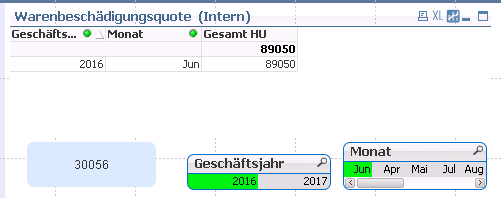Unlock a world of possibilities! Login now and discover the exclusive benefits awaiting you.
- Qlik Community
- :
- All Forums
- :
- QlikView App Dev
- :
- Re: Different Result for same expression in TextOb...
- Subscribe to RSS Feed
- Mark Topic as New
- Mark Topic as Read
- Float this Topic for Current User
- Bookmark
- Subscribe
- Mute
- Printer Friendly Page
- Mark as New
- Bookmark
- Subscribe
- Mute
- Subscribe to RSS Feed
- Permalink
- Report Inappropriate Content
Different Result for same expression in TextObject and Chart
Hallo Community
I have a problem and at the moment no more ideas how I can solve it or where/what the real problem is.
I use following expression in a text object and in a straight table:
=Count({<$(=vSetAnalysisPosTyp1)>} HU)
text object -> this is the right result

straight table

But at the end i have for the same selection two different results

I hope someone can help me.
Why I get different results for the same expression? How I can find the right result in the straight table.
Regards
Philipp
- « Previous Replies
-
- 1
- 2
- Next Replies »
- Mark as New
- Bookmark
- Subscribe
- Mute
- Subscribe to RSS Feed
- Permalink
- Report Inappropriate Content
HI
Could you please post a sample file to verify the expression.
Please close the thread by marking correct answer & give likes if you like the post.
- Mark as New
- Bookmark
- Subscribe
- Mute
- Subscribe to RSS Feed
- Permalink
- Report Inappropriate Content
The reason will be that your expression within the table will be consider their dimension while within the textbox it will be calculated globally. In your case I assume that you used dimensions which are from more then one table and which are not be associated in the right way so that the table-dimensions are blown up.
- Marcus
- Mark as New
- Bookmark
- Subscribe
- Mute
- Subscribe to RSS Feed
- Permalink
- Report Inappropriate Content
Here the example
- Mark as New
- Bookmark
- Subscribe
- Mute
- Subscribe to RSS Feed
- Permalink
- Report Inappropriate Content
Hi
In text box, your expression is
=Count({<$(=vSetAnalysisPosTyp1)>} distinct HU)
And your chart expression is
=Count({<$(=vSetAnalysisPosTyp1)>} HU).
So please change the chart expression to
=Count({<$(=vSetAnalysisPosTyp1)>} distinct HU)
| Geschäftsjahr | Monat | Gesamt HU |
|---|---|---|
| 32636 | ||
| 2016 | Jun | 32636 |
Please close the thread by marking correct answer & give likes if you like the post.
- Mark as New
- Bookmark
- Subscribe
- Mute
- Subscribe to RSS Feed
- Permalink
- Report Inappropriate Content
Hi,
You are missing Distinct Keyword in chart expression.
Regards
Please appreciate our Qlik community members by giving Kudos for sharing their time for your query. If your query is answered, please mark the topic as resolved 🙂
- Mark as New
- Bookmark
- Subscribe
- Mute
- Subscribe to RSS Feed
- Permalink
- Report Inappropriate Content
sorry in the example i added the wrong text object.![]()
in this new file is the text object without distinct and less hus then in the straight table
- Mark as New
- Bookmark
- Subscribe
- Mute
- Subscribe to RSS Feed
- Permalink
- Report Inappropriate Content
Hi
Instead of HU , try like below in chart
=Count({<$(=vSetAnalysisPosTyp1)>} [HU Pos])
Chart is calculates based on dimension like Year and Month. So there is duplication will occur.
Text box is calculate overall (without any dimension)
Please close the thread by marking correct answer & give likes if you like the post.
- Mark as New
- Bookmark
- Subscribe
- Mute
- Subscribe to RSS Feed
- Permalink
- Report Inappropriate Content
Your expression is different in the chart and the text object,
In the expression in your chart,
add distinct to your expression,
i.e. =Count({<$(=vSetAnalysisPosTyp1)>} distinct HU)
Regards,
Anjali Gupta
- Mark as New
- Bookmark
- Subscribe
- Mute
- Subscribe to RSS Feed
- Permalink
- Report Inappropriate Content
but i need the HU-Field not the HU Pos Field
- « Previous Replies
-
- 1
- 2
- Next Replies »